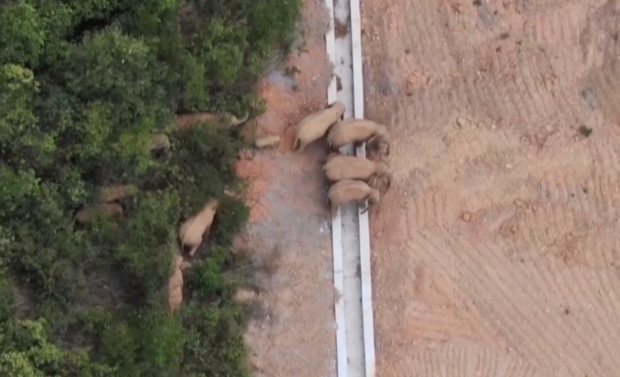Elephants teach us to live in harmony with nature

Screenshot from a CCTV video via AFP
The herd of elephants moving north after leaving the Xishuangbanna National Nature Reserve in Yunnan province has drawn widespread public attention, with tens of millions of people following its movement on TV programs and social media platforms.
But this is not the first time wild Asian Elephants have wandered away from their habitat and headed northward, only this time the herd has traveled more than 400 kilometers to Kunming. Photographs, videos and stories of the herd’s movement have sparked widespread discussions even overseas.
However, there is a need to go behind the “cute photos” and the seemingly “fantastic” event and identify the reasons why wild elephants are leaving their habitat, and find ways to establish harmonious human-animal relationship within habitats and the surrounding forests and human settlements. It is important to scientifically demarcate the habitats for elephants and other animals in Xishuangbanna and elsewhere in the country for ecological reasons as well.
A number of afforestation projects have been undertaken in China to expand forest cover, including the “Green for Grain National Program”. The “Natural Forest Conservation Program” on the other hand is aimed at protecting natural forest resources and preventing further degradation of forests. Such programs have resulted in immense benefits for forests, water and soil and can be considered a big milestone in the development of “ecological civilization”.
Planting trees is a key and fundamental step toward restoration of nature. Yet long-term investment and a more scientific approach are needed to maintain the remaining forests as well as to extend the forest cover and strengthen conservation.
However, tree cover alone doesn’t mean a suitable habitat for all animals, for different species need different types of vegetation to survive and breed.
The elephant herd in Yunnan is a reminder that we have to scientifically conserve the existing forests and turn them into suitable habitats for different species of animals and birds, which will ultimately benefit humans.
More ambitious targets should be set to re-build or improve the food chain, and measures taken to ensure forest resources help wildlife flourish, in order to establish a harmonious human-animal relationship.
In the past, attention was rarely paid to the integrity of the forest ecosystem. Building a suitable habitat for animals is a long-term process that involves scientific management and restoration efforts with multiple targets. In particular, we need to improve our understanding of wildlife, food chain and the animal-forest relationship, and ensure that forests provide sufficient food, water and shelter for wildlife, while taking measures to minimize human interference in forests. This task needs the collective efforts of all conservationists, decision-makers and the people living in and around forests.
The Earth can become greener with China’s restoration efforts, which can also prompt other countries to strengthen their forest conservation efforts, especially those countries that face deforestation and degradation of natural resources.
In fact, forests around the globe are still shrinking, particularly those in tropical and developing countries. About 43 million hectares of forests have disappeared due to deforestation in the past more than 10 years. And experts forecast that another 200 million hectares could be lost by 2030 if we do not take immediate remedial measures.
The next decade therefore will be crucial for the world’s forests and wildlife, and China can play a leading role in saving them by better protecting its forests and expanding its forest cover.
Reducing, if not altogether ending, human-wildlife conflict is another task toward conservation of forests and wildlife. Nature conservation is entering a new stage in China. That more wild animals are becoming visible indicates the natural environment is improving. As such, people should develop a more inclusive attitude toward wildlife to prevent human-animal conflict.
As a conservation organization with a network spread across more than 100 countries, we at the World Wide Fund for Nature suggest that human-wildlife conflict management be integrated into the overall wildlife management system, with more active and pragmatic policy and action to mitigate such conflicts. The authorities could refer to some international experiences and practices when it comes to monitoring, evaluating and responding to given situations.
In short, the future goal of mitigating human-wildlife conflict should be “coexistence of humans and animals”, which is also the way forward to realize “harmonious coexistence of human and nature” and building an ecological civilization.
The author, Huang Wenbin, is Beijing Regional Head of WWF China.
The views don’t necessarily reflect those of China Daily and INQUIRER.net.




















